YAMAHA FX HO CRUISER 2019 Owner's Manual
Manufacturer: YAMAHA, Model Year: 2019, Model line: FX HO CRUISER, Model: YAMAHA FX HO CRUISER 2019Pages: 116, PDF Size: 12.33 MB
Page 21 of 116
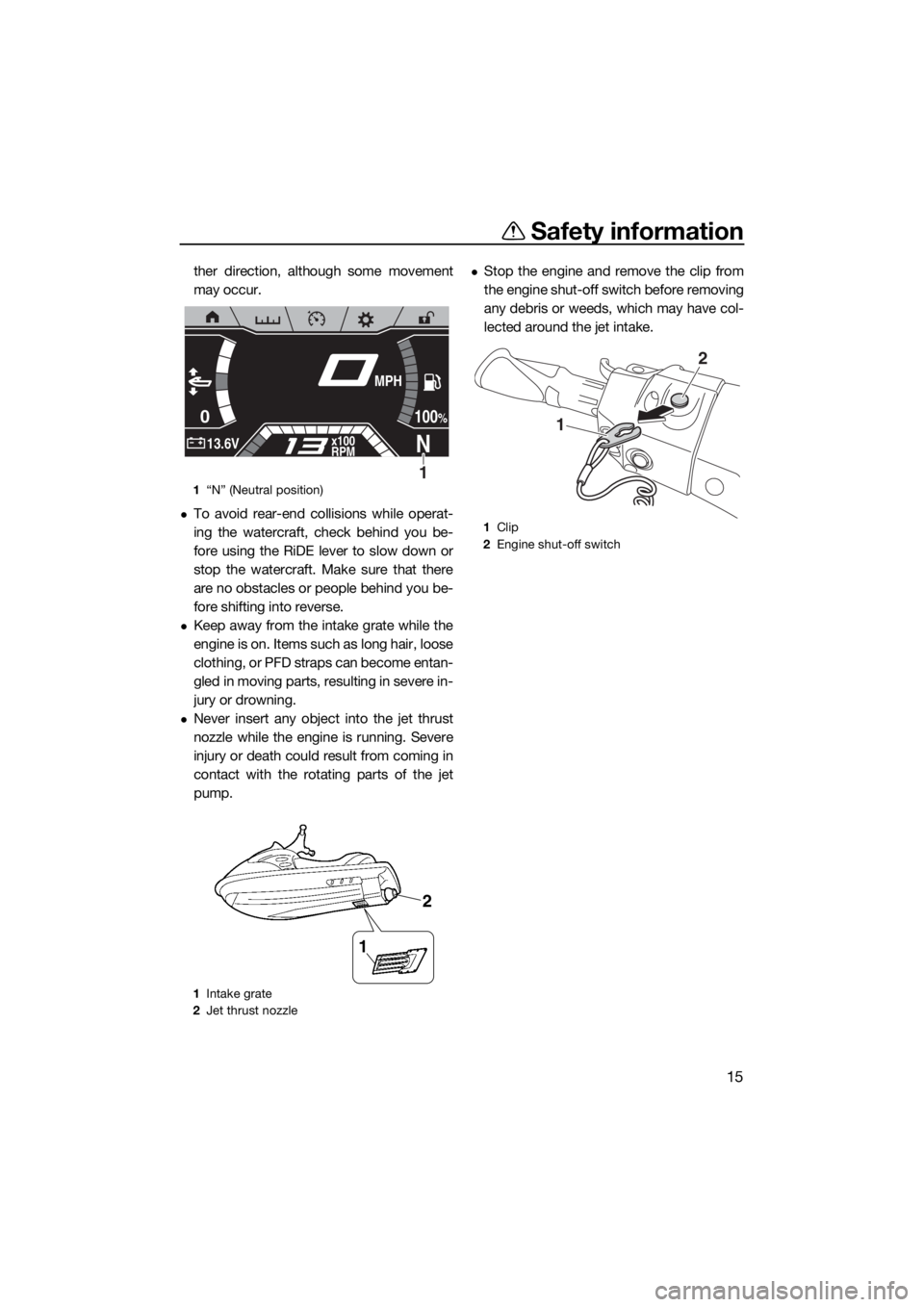
Safety information
15
ther direction, although some movement
may occur.
To avoid rear-end collisions while operat-
ing the watercraft, check behind you be-
fore using the RiDE lever to slow down or
stop the watercraft. Make sure that there
are no obstacles or people behind you be-
fore shifting into reverse.
Keep away from the intake grate while the
engine is on. Items such as long hair, loose
clothing, or PFD straps can become entan-
gled in moving parts, resulting in severe in-
jury or drowning.
Never insert any object into the jet thrust
nozzle while the engine is running. Severe
injury or death could result from coming in
contact with the rotating parts of the jet
pump.
Stop the engine and remove the clip from
the engine shut-off switch before removing
any debris or weeds, which may have col-
lected around the jet intake.
1“N” (Neutral position)
1Intake grate
2Jet thrust nozzle
0
N13.6Vx100
RPM
100%
MPH
1
1
2
1Clip
2Engine shut-off switch
2
1
UF3V70E0.book Page 15 Tuesday, August 28, 2018 10:16 AM
Page 22 of 116

Safety information
16
EJU30957
Wakeboarding and water-
skiing
You can use the watercraft for wakeboarding
or water-skiing if it has the seating capacity to
carry the operator, a rearward-facing spotter,
and the wakeboarder or water-skier when he
or she is not being pulled.
The watercraft must also have a cleat de-
signed to pull a ski rope; do not attach the
rope to any other location.
It is the watercraft operator’s responsibility to
be alert to the safety of the wakeboarder or
water-skier and others. Know and follow all
local regulations in effect for the waters in
which you will be operating.
The operator should be comfortable carrying
passengers before attempting to pull a wake-
boarder or water-skier.
The following are some important consider-
ations for minimizing risks while pulling a
wakeboarder or water-skier.
The wakeboarder or water-skier should
wear an approved PFD, preferably a bright-
ly colored one so boat operators can see
the person being pulled.
The wakeboarder or water-skier should
wear protective clothing. Severe internal in-
juries can occur if water is forced into body
cavities as a result of falling into the water.Normal swimwear does not adequately
protect against forceful water entry into the
rectum or vagina. The person being pulled
should wear a wetsuit bottom or clothing
that provides equivalent protection.
A second person should be on board as a
spotter to watch the wakeboarder or wa-
ter-skier; in many places it is required by
law. Let the person being pulled direct the
operator’s control of speed and direction
with hand signals.
The spotter should sit astride the rear of the
seat and hold onto the handgrip with both
feet firmly on the floor of the footwell for
proper balance while facing to the rear to
watch the wakeboarder’s or water-skier’s
hand signals and condition.
Your control while pulling a wakeboarder or
water-skier is affected by the wakeboard-
1Cleat
1
1Handgrip
1Handgrip
1
UF3V70E0.book Page 16 Tuesday, August 28, 2018 10:16 AM
Page 23 of 116

Safety information
17
er’s or water-skier’s ability, as well as water
and weather conditions.
When preparing to pull a wakeboarder or
water-skier, operate the watercraft at the
slowest possible speed until the watercraft
is well away from the person being pulled
and slack in the ski rope is taken up. Make
sure that the rope is not looped around
anything.
After checking that the wakeboarder or wa-
ter-skier is ready and that there is no traffic
or other obstacles, apply enough throttle to
raise the person.
Make smooth, wide turns. The watercraft is
capable of very sharp turns, which could
exceed the abilities of the wakeboarder or
water-skier. Keep the person being towed
at least 50 m (164 ft), about twice the dis-
tance of a standard ski rope, away from
any potential hazard.
The operators of boats and other water-
craft may not be aware that you are pulling
a wakeboarder or water-skier. Together
with the spotter, pay attention to others
around you and cruise at safe speeds.
Be alert to the hazard of the ski rope handle
snapping back at the watercraft when the
wakeboarder or water-skier falls or is un-
able to get up.
Towing heavy or bulky objects other than
wakeboarders or water-skiers, such as an-
other boat or watercraft, can cause loss of
steering control and create a hazardous
condition. If you must tow another boat in
an emergency situation, operate slowly
and cautiously.
EJU30971
Safe boating rules
Your Yamaha watercraft is legally considered
a powerboat. Operation of the watercraft
must be in accordance with the rules and
regulations governing the waterway on which
it is used.
UF3V70E0.book Page 17 Tuesday, August 28, 2018 10:16 AM
Page 24 of 116

Safety information
18
EJU30992
Enjoy your watercraft
responsibly
You share the areas you enjoy when riding
your watercraft with others and with nature.
So your enjoyment includes a responsibility
to treat these other people, and the lands,
waters, and wildlife with respect and courte-
sy.
Whenever and wherever you ride, think of
yourself as the guest of those around you.
Remember, for example, that the sound of
your watercraft may be music to you, but it
could be just noise to others. And the exciting
splash of your wake can make waves others
won’t enjoy.
Avoid riding close to shoreline homes and
waterfowl nesting areas or other wildlife ar-
eas, and keep a respectful distance from fish-
ermen, other boats, swimmers, and
populated beaches. When travel in areas like
these is unavoidable, ride slowly and obey all
laws.
Proper maintenance is necessary to ensure
that the exhaust emission and sound levels of
your watercraft will continue to be within reg-
ulated limits. You have the responsibility to
make sure that the recommended mainte-
nance in this owner’s/operator’s manual is
carried out.
Remember, pollution can be harmful to the
environment. Do not refuel or add oil where a
spill could cause damage to nature. Remove
your watercraft from the water and move it
away from the shoreline before refueling. Dis-
pose of water and any fuel and oil residue in
the engine compartment according to local
regulations. And keep your surroundings
pleasant for the people and wildlife that share
the waterways: don’t litter.When you ride responsibly, with respect and
courtesy for others, you help ensure that our
waterways stay open for the enjoyment of a
variety of recreational opportunities.
UF3V70E0.book Page 18 Tuesday, August 28, 2018 10:16 AM
Page 25 of 116

Description
19
EJU43331
Watercraft glossary
Trolling speed
“Trolling” is the lowest maneuvering speed. You are applying little or no throttle. The water-
craft is down in the water, and there is no wake.
Sub-planing speed
“Sub-planing” is a medium speed. The bow of the watercraft is slightly up from the water sur-
face, but you are still traveling through the water. There is a wake.
Planing speed
“Planing” is a faster speed. The watercraft is more level and is skimming on top of the water.
There is a wake.
Bow
The front end of the watercraft.
Stern
The rear end of the watercraft.
Starboard
The right side of the watercraft when facing forward.
Port
The left side of the watercraft when facing forward.
Bilge water
Water that has collected in the engine compartment.
Yamaha Engine Management System (YEMS)
YEMS is an integrated, computerized management system that controls and adjusts ignition
timing, fuel injection, engine diagnostics, and the off-throttle steering (OTS) system.
Reverse with Intuitive Deceleration Electronics (RiDE)
RiDE is an electronic system that controls the reverse, neutral, and deceleration operations of
the watercraft.
UF3V70E0.book Page 19 Tuesday, August 28, 2018 10:16 AM
Page 26 of 116
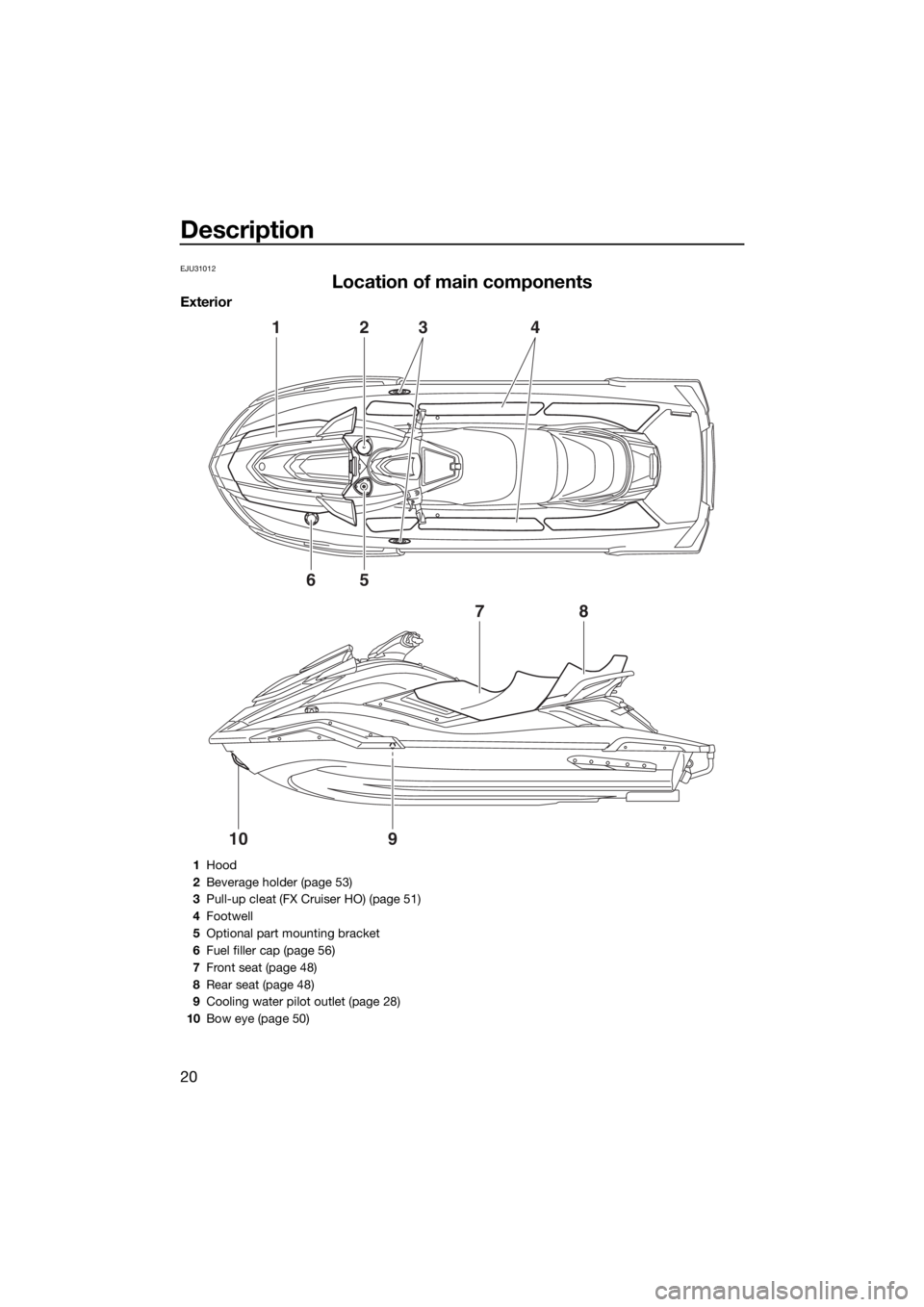
Description
20
EJU31012
Location of main components
Exterior
1
6
78
910
5
234
1Hood
2Beverage holder (page 53)
3Pull-up cleat (FX Cruiser HO) (page 51)
4Footwell
5Optional part mounting bracket
6Fuel filler cap (page 56)
7Front seat (page 48)
8Rear seat (page 48)
9Cooling water pilot outlet (page 28)
10Bow eye (page 50)
UF3V70E0.book Page 20 Tuesday, August 28, 2018 10:16 AM
Page 27 of 116
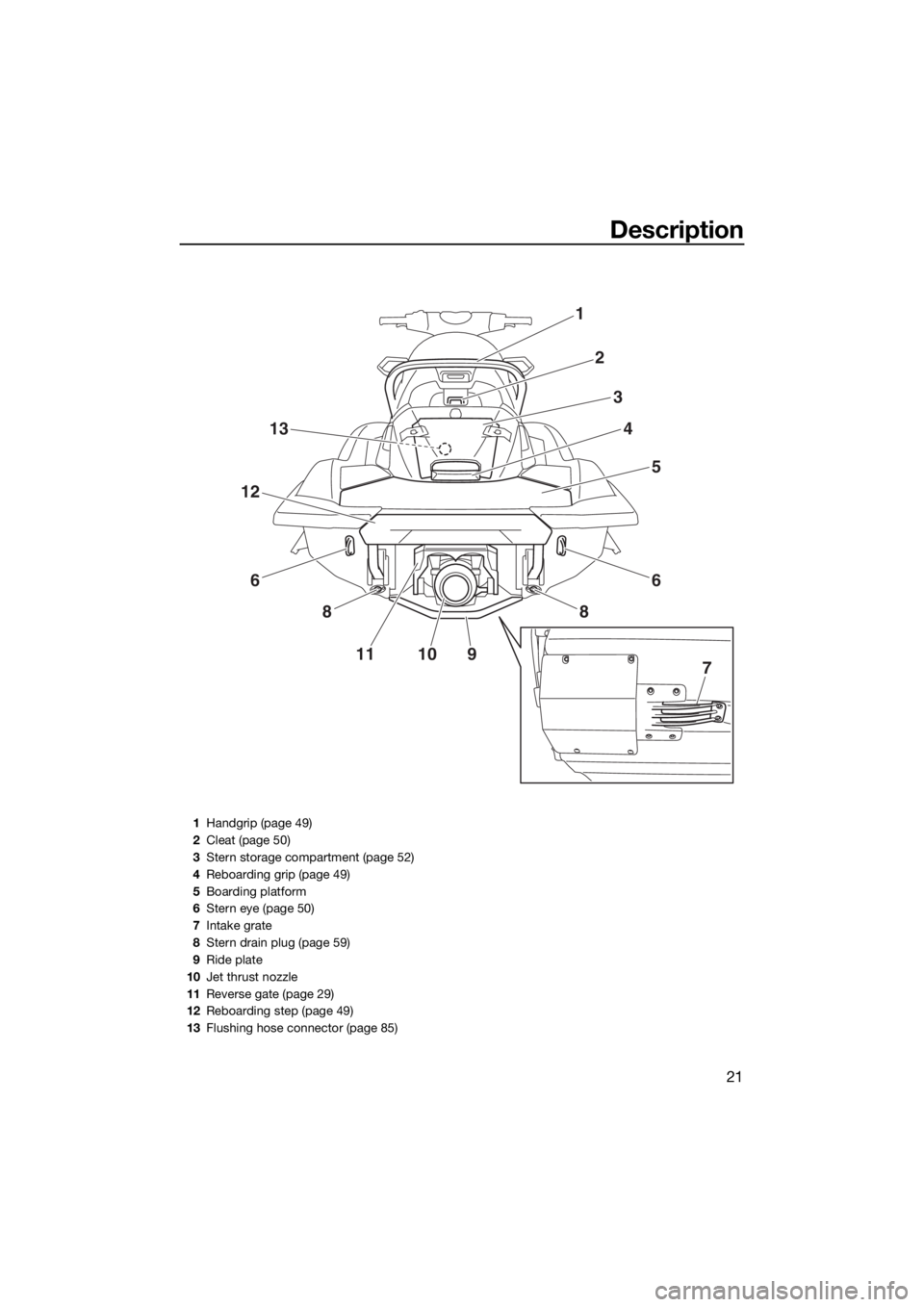
Description
21
1
2
3
4
5
6
8
13
12
6
8
111097
1Handgrip (page 49)
2Cleat (page 50)
3Stern storage compartment (page 52)
4Reboarding grip (page 49)
5Boarding platform
6Stern eye (page 50)
7Intake grate
8Stern drain plug (page 59)
9Ride plate
10Jet thrust nozzle
11Reverse gate (page 29)
12Reboarding step (page 49)
13Flushing hose connector (page 85)
UF3V70E0.book Page 21 Tuesday, August 28, 2018 10:16 AM
Page 28 of 116
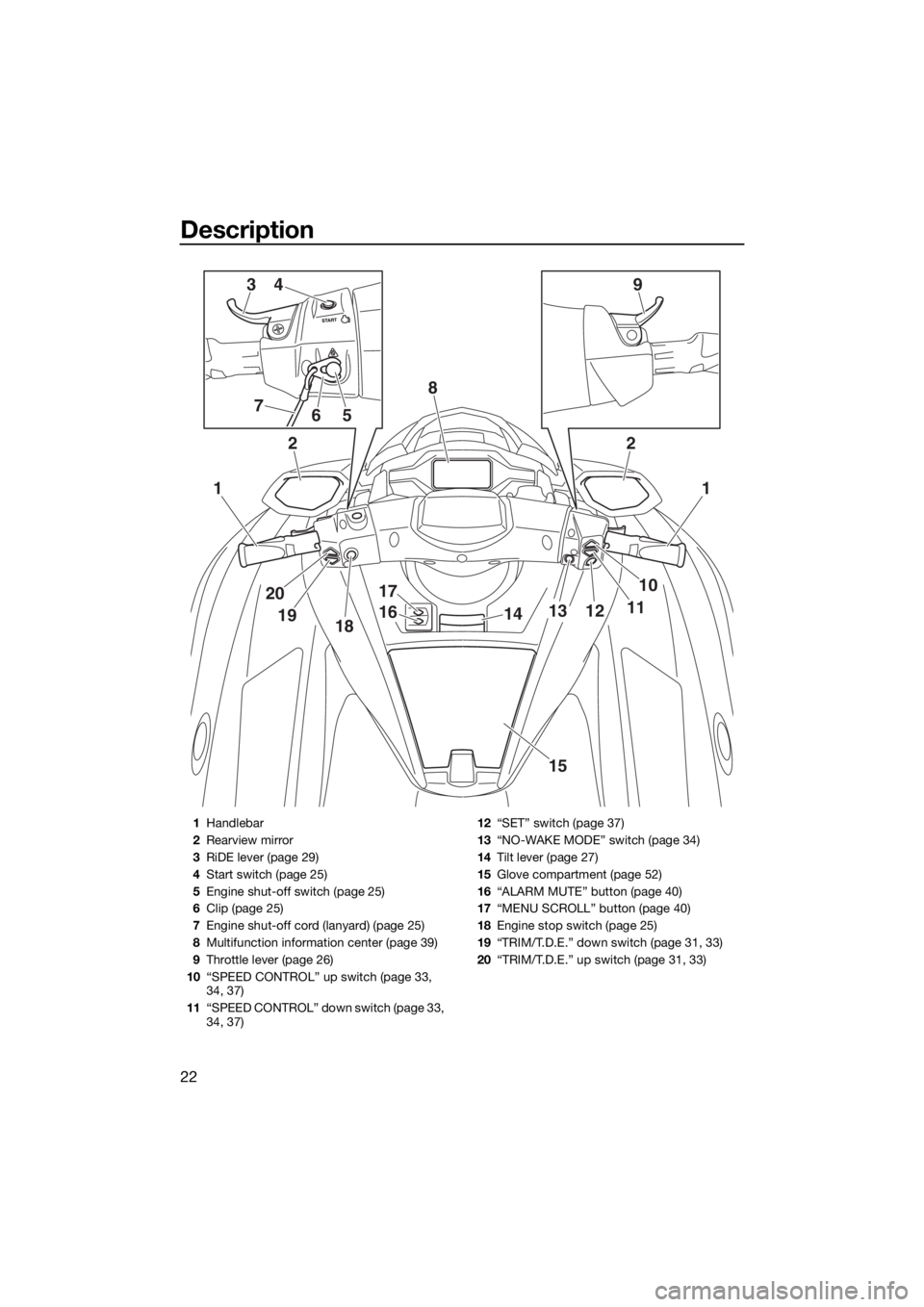
Description
22
1
2
1
10
111213
20
1918
17
1614
15
2
8
394
567
1Handlebar
2Rearview mirror
3RiDE lever (page 29)
4Start switch (page 25)
5Engine shut-off switch (page 25)
6Clip (page 25)
7Engine shut-off cord (lanyard) (page 25)
8Multifunction information center (page 39)
9Throttle lever (page 26)
10“SPEED CONTROL” up switch (page 33,
34, 37)
11“SPEED CONTROL” down switch (page 33,
34, 37)12“SET” switch (page 37)
13“NO-WAKE MODE” switch (page 34)
14Tilt lever (page 27)
15Glove compartment (page 52)
16“ALARM MUTE” button (page 40)
17“MENU SCROLL” button (page 40)
18Engine stop switch (page 25)
19“TRIM/T.D.E.” down switch (page 31, 33)
20“TRIM/T.D.E.” up switch (page 31, 33)
UF3V70E0.book Page 22 Tuesday, August 28, 2018 10:16 AM
Page 29 of 116
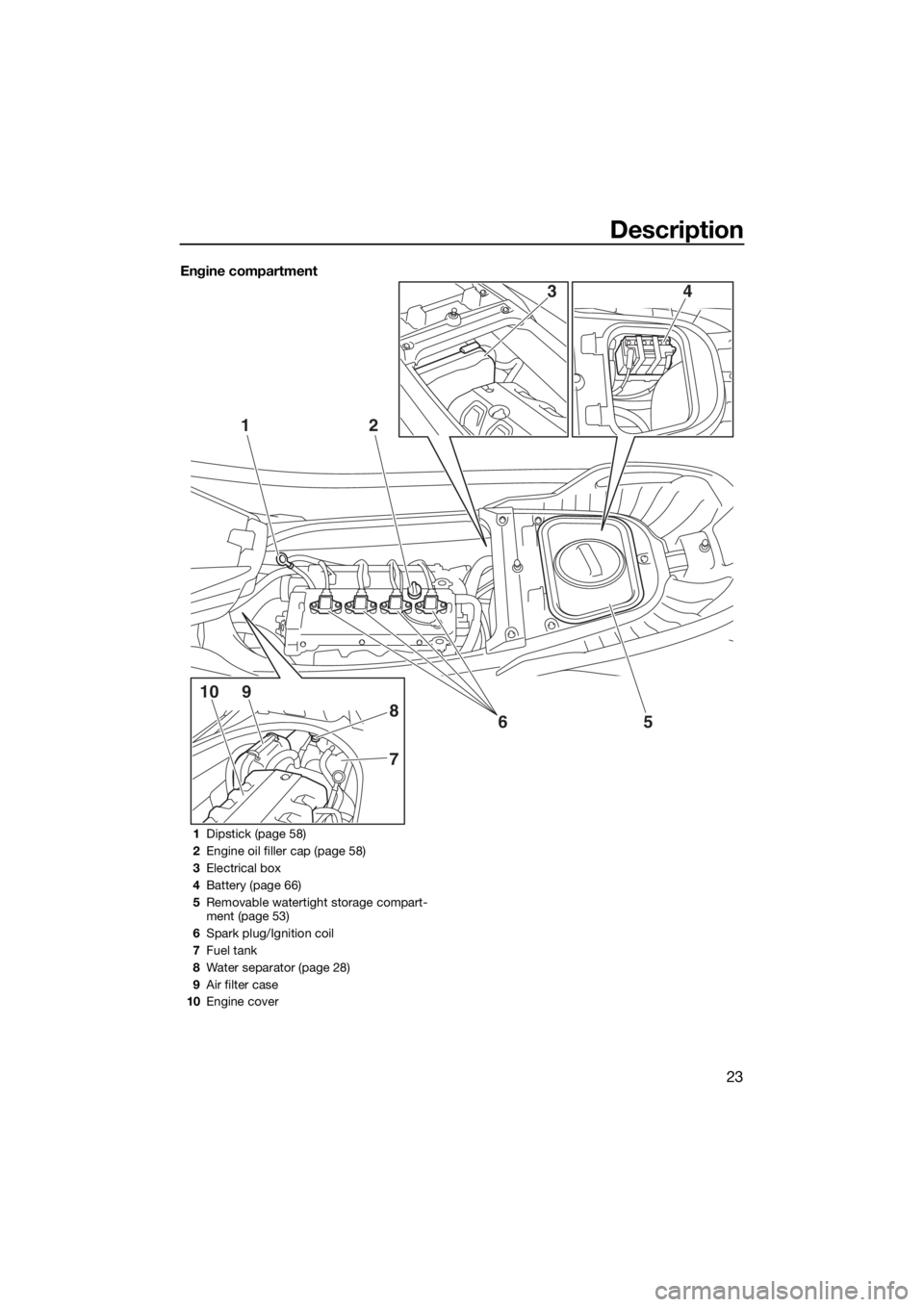
Description
23
Engine compartment
12
5
7
8
910
6
43
1Dipstick (page 58)
2Engine oil filler cap (page 58)
3Electrical box
4Battery (page 66)
5Removable watertight storage compart-
ment (page 53)
6Spark plug/Ignition coil
7Fuel tank
8Water separator (page 28)
9Air filter case
10Engine cover
UF3V70E0.book Page 23 Tuesday, August 28, 2018 10:16 AM
Page 30 of 116
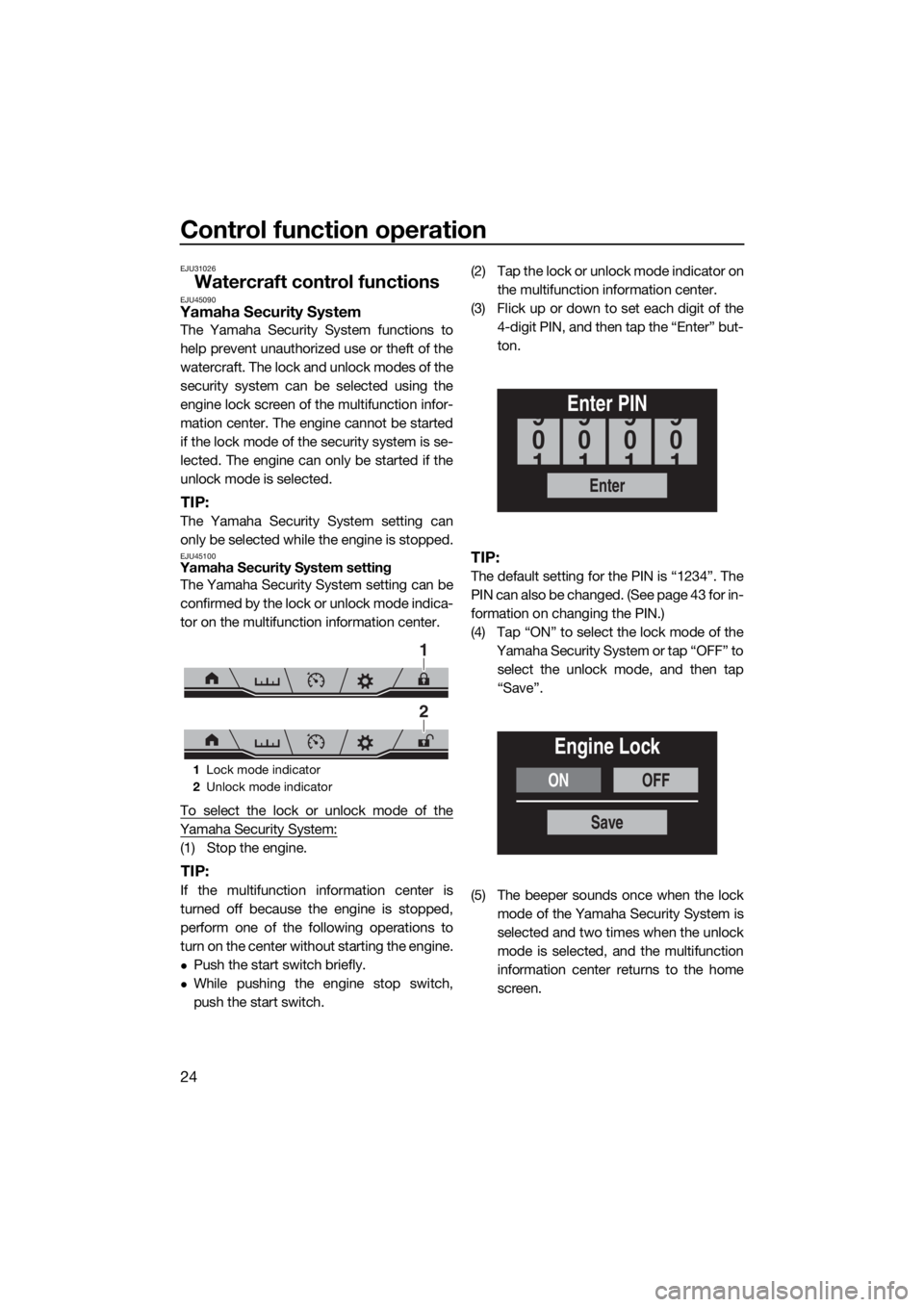
Control function operation
24
EJU31026
Watercraft control functionsEJU45090Yamaha Security System
The Yamaha Security System functions to
help prevent unauthorized use or theft of the
watercraft. The lock and unlock modes of the
security system can be selected using the
engine lock screen of the multifunction infor-
mation center. The engine cannot be started
if the lock mode of the security system is se-
lected. The engine can only be started if the
unlock mode is selected.
TIP:
The Yamaha Security System setting can
only be selected while the engine is stopped.
EJU45100Yamaha Security System setting
The Yamaha Security System setting can be
confirmed by the lock or unlock mode indica-
tor on the multifunction information center.
To select the lock or unlock mode of the
Yamaha Security System:
(1) Stop the engine.
TIP:
If the multifunction information center is
turned off because the engine is stopped,
perform one of the following operations to
turn on the center without starting the engine.
Push the start switch briefly.
While pushing the engine stop switch,
push the start switch.(2) Tap the lock or unlock mode indicator on
the multifunction information center.
(3) Flick up or down to set each digit of the
4-digit PIN, and then tap the “Enter” but-
ton.
TIP:
The default setting for the PIN is “1234”. The
PIN can also be changed. (See page 43 for in-
formation on changing the PIN.)
(4) Tap “ON” to select the lock mode of the
Yamaha Security System or tap “OFF” to
select the unlock mode, and then tap
“Save”.
(5) The beeper sounds once when the lock
mode of the Yamaha Security System is
selected and two times when the unlock
mode is selected, and the multifunction
information center returns to the home
screen.
1Lock mode indicator
2Unlock mode indicator
1
2
Enter
Enter PIN
0
9
1
0
9
1
0
9
1
0
9
1
ONOFF
Engine Lock
Save
UF3V70E0.book Page 24 Tuesday, August 28, 2018 10:16 AM